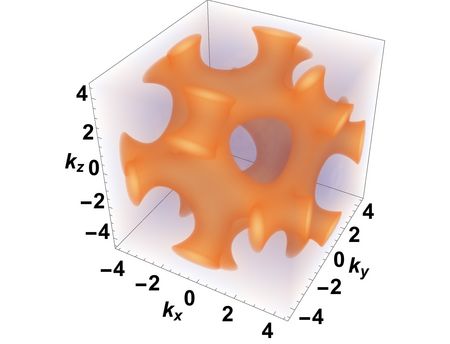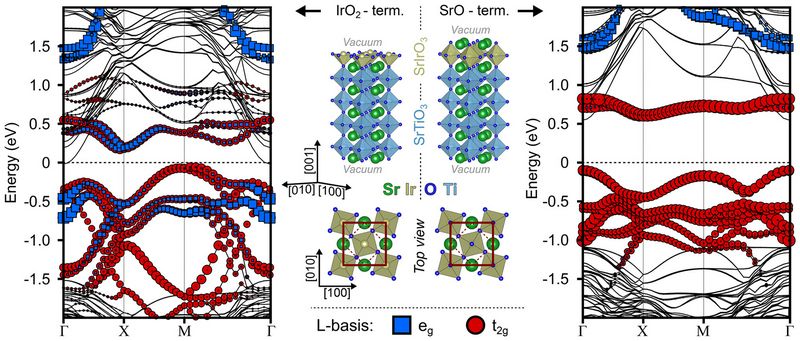MATERIALS SCIENCE AND CHEMISTRY
Numerical Simulations of Topological and Correlated Quantum Matter
Principal Investigator:
Fakher Assaad
Affiliation:
Lehrstuhl für Theoretische Physik I, Julius-Maximilian-Universität Würzburg
Local Project ID:
pr94vu
HPC Platform used:
SuperMUC and SuperMUC-NG of LRZ
Date published:
Introduction
To unravel the complexity of the solid state, complementary state-of-the-art numerical approaches are required. In Würzburg, a number of researchers embedded in the SFB 1170 on Topological and Correlated Electronics at Surfaces and Interfaces, are in the unique position of mastering a number of very different and complementary methods which will allow for progress. On one hand one can start with density functional theory in the local density approximation and then add dynamical local interactions using the so-called dynamical mean-field approximation. This approach has the merit of being material dependent in the sense that it is possible to include the specific chemical constituents of the material under investigation. Progress in this domain will be described below.
Spacial fluctuations alongside temporal ones are crucial to understand a number of materials. In this project, we concentrate on magnetic materials in three spatial dimensions, and test the new pseudo-fermion functional renormalization group (PFFRG) method to understand aspects of frustrated magnetism in three spatial dimensions. Here, the approach is tested against exact QMC simulations. Testing the quality of this tool is important due to its potential application in the domain of Iridates.
Another aspect of our research deals with realistic quantum Monte Carlo simulations of free-standing graphene aiming at elucidating the role of the electronic correlations. Access to the LRZ supercomputing center is imperative to carry out the relevant simulations on a wide range of models and to cover the parameter space. In all cases, access to supercomputers allows to carry out simulations on larger and larger system sizes, enabling extrapolation to the thermodynamic limit which is relevant for the understanding of experiments and collective phenomena.
The magnetic fluctuation profiles of 3D frustrated magnets
The search for unconventional phases of matter, such as quantum spin liquids, is one of the fundamental and most debated issues in condensed matter physics. Traditionally, frustrated quantum magnets in 2D are a promising arena to look for such topological phases [1]. However, tremendously exciting developments and discoveries of exotic magnetism and spin liquid physics have been made experimentally in 3D frustrated quantum magnets. In particular, neutron scattering experiments on Hyper-Kagome (Na4Ir3O8), Hyper-Honeycomb (Li2IrO3), and various Pyrochlore and Double-Perovskite systems have revealed a novel magnetic fluctuation profile, which has so far lacked any theoretical understanding. This is because of a complete absence of any numerical quantum manybody method which can be used for a microscopic investigation of 3D systems, for a system size large enough to make connection with experimental data. However, the very recent development and successful application of the pseudo-fermion functional renormalization group (PFFRG) method to record large (>4000 sites) 3D systems [2] has shown it to be a promising approach, able to access system sizes which are an order or magnitude larger than those achievable by other methods; this is made possible by a straightforward parallelizability of the RG flow equations. However, its successful application proves to be computationally extremely intensive and requires massive parallelization of the RG flow equations.
Given the resources of the SuperMUC our goal is to explain the observed magnetic fluctuation profile of 3D frustrated magnets (see Fig. 1) using spin models of magnetism which are known to accurately capture the physics. These efforts are coordinated with the ab-initio DFT calculations in the group of Prof. G. Sangiovanni, in order to understand the microscopic origin of the couplings in the materials and to provide estimates of the same, which form the starting point of our FRG calculations.
Ab-initio study of iridate heterostructures
Iridium is also the protagonist of another fascinating line of research of the many-body physics of 5d correlated electrons. Its spin-orbit interaction competes indeed so strongly with the Coulomb repulsion, that compounds differing only in small structural details can display dramatically different electronic and magnetic properties. This is for instance the case of perovskite-like iridium strontium-oxides of the Ruddlesden-Popper series Srn+1IrnO3n+1: While the n=1 (214) compound is a quasi-two dimensional Mott system and the n=2 (327) a narrow-gap antiferromagnetic insulator, the n=∞ (113) is a correlated metal on the verge of a ferromagnetic instability [3].
Nowadays a big effort focuses on controlling and tuning these properties by heterostructuring iridium-oxides and growing them on different substrates. The success or the failure of these attempts is strongly bound to our ability of making reliable theoretical predictions. The physical effects playing a role in this class of materials are many, from strong mass enhancement of electronic quasiparticles, to sizeable scattering due to electron-electron interaction, from magnetic instabilities to spin-orbit-driven physics.
For this reason, the theoretical modeling is extremely challenging and it requires large-scale computational resources, like those available at the Leibniz Supercomputing Centre with the SuperMUC HPC-system. We performed Density Functional Theory (DFT) calculations of SrIrO3-films on SrTiO3 [4], in close contact with the group of Ralph Claessen at the University of Würzburg, where these heterostructures are currently grown and experimentally investigated.
To accommodate the out-of-plane tilting of the oxygen-octahedra and the epitaxially grown films, we used unit cells containing up to 150 atoms. The atomic relaxation in the presence of magnetism and interactions due to the Hubbard interaction with strength U turned out to be extremely heavy, considering in particular the fact that the calculations included spin-orbit coupling. Since we also need a correct description of the paramagnetic phase above the magnetic ordering temperature, approaches beyond DFT are highly desirable. We will address this with our hybridization-expansion continuous time quantum Monte Carlo code for Dynamical Mean Field Theory (DMFT) calculations called “w2dynamics” [5]. We highly optimized our code package over the years to treat systems that have a size at the border of feasibility. It is already installed on SuperMUC and shows high performance and perfect scalability.
The DFT calculations were done with VASP (already installed and optimized on SuperMUC) for heterostructures with a different number of Ir-layers ranging from 1 to 4 [4]. For each of these cases we explored different magnetic orders, different terminations, oxygen vacancies and clusters thereof. The role of the surface termination, an often-overlooked property of transition metal oxide thin films, was carefully investigated. Our accurate DFT calculations brought evidence of a terminating SrO surface layer, in agreement with experimental results [6].
The role of electron-electron interactions in two-dimensional Dirac fermions
The role of electron-electron interactions in two-dimensional Dirac fermion systems remains enigmatic. Using a combination of nonperturbative numerical and analytical techniques that incorporate both the contact and long-range parts of the Coulomb interaction, one can identify two previously discussed regimes: a Gross-Neveu transition to a strongly correlated Mott insulator and a semi-metallic state with a logarithmically diverging Fermi velocity accurately described by the random phase approximation. Using large scale quantum Monte Carlo simulations [7] one can show that experimental realizations of Dirac fermions span this crossover and that this determines whether the Fermi velocity is increased or decreased by interactions. This explains several long-standing mysteries, including why the observed Fermi velocity in graphene is consistently about 20% larger than values obtained from ab initio calculations and why graphene on different substrates shows different behaviors.
References and links
[1] Y. Iqbal, W.-J. Hu, R. Thomale, D. Poilblanc, and F. Becca, “Spin liquid nature in the Heisenberg J1 – J2 triangular antiferromagnet”, Phys. Rev. B 93, 14 4411 (2016)
[2] Y. Iqbal, R. Thomale, F. Parisen Toldin, S. Rachel, J. Reuther, “Functional Renormalization Group for threedimensional Quantum Magnetism,” Phys. Rev. B 94, 140408(R) (2016)
[3] Y. K. Kim, O. Krupin, J. D. Denlinger, A. Bostwick, E. Rotenberg, Q. Zhao, J. F. Mitchell, J. W. Allen, B. J. Kim, “Fermi arcs in a doped pseu-dospin-1/2 Heisenberg antiferromagnet,” Science 345, 187 (2014)
[4] P. Schütz, D. Di Sante, L. Dudy, J. Gabel, M. Stübinger, M. Kamp, Y. Huang, M. Capone, M.-A. Husanu, V. N. Strocov, G. Sangiovanni, M. Sing, and R. Claessen, “Dimensionality-Driven Metal-Insulator Transition in Spin-Orbit-Coupled SrIrO3”, Phys. Rev. Lett. 119, 256404 (2017)
[5] N. Parragh, A. Toschi, K. Held, and G. Sangiovanni, ”Conserved quantities of SU(2)-invariant interactions for correlated fermions and the advantages for quantum Monte Carlo simulations,” Phys. Rev. B 86, 155158 (2012)
[6] P. Schütz, M. Kamp, D. Di Sante, A. Lubk, B. Büchner, G. Sangiovanni, M. Sing, and R. Claessen, “Electronic structure of epitaxial perovskite films in the two-dimensional limit: Role of the surface termination”, Appl. Phys. Lett. 116, 201601 (2020)
[7] H.-K. Tang, J. N. Leaw, J. N. B. Rodrigues, I. F. Herbut, P. Sengupta, F. F. Assaad, and S. Adam, “The role of electron-electron interactions in two-dimensional Dirac fermions,” Science, vol. 361, no. 6402, pp. 570–574, 2018.
Scientific Contact
Prof. Dr. Fakher Assaad
Theoretische Physik I
Julius-Maximilians-Universität Würzburg
Am Hubland, D-97074 Würzburg (Germany)
e-mail: fakher.assaad [@] physik.uni-wuerzburg.de
Local project ID: pr94vu
September 2020

